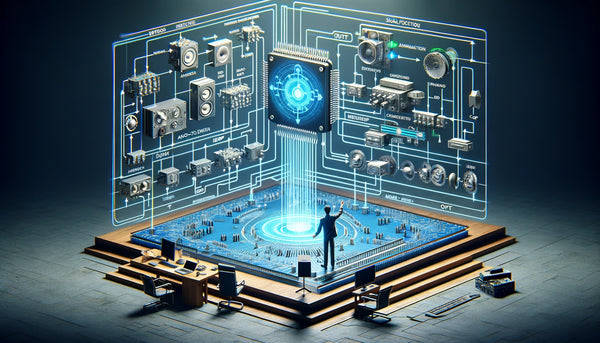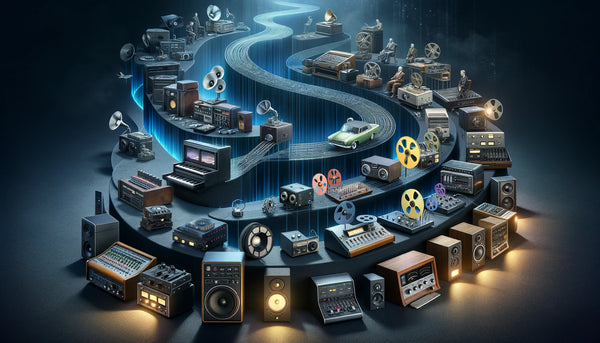Key Highlights
- Digital Signal Processing (DSP) is a crucial component in modern audio equipment, enhancing sound quality and enabling various audio processing features.
- DSP technology is found in various devices like headphones, smartphones, smart speakers, studio gear, and vehicle entertainment systems.
- DSP chips are designed to perform mathematical functions quickly and efficiently, consuming less power than traditional CPUs.
- DSP enhances the audio experience by improving sound quality, noise cancellation, and echo reduction, and optimizing audio gear.
- DSP significantly impacts music production, transforming analog audio signals into digital signals for better audio quality.
- DSP is widely used in consumer electronics, including home audio systems, wireless headphones, and smartphones, and its future in these devices looks promising.
Introduction

Digital Signal Processing (DSP) is playing a significant role in revolutionizing the audio industry. As technology advances, DSP has become a key innovation that enhances sound quality, enables advanced audio processing features, and improves the overall audio experience for consumers.
DSP technology can be found in various audio devices, from headphones and smartphones to smart speakers and studio audio gear. It is responsible for processing digital audio signals and performing mathematical functions to manipulate and enhance the audio output. DSP chips, specifically designed for audio processing, can perform these functions quickly and efficiently, consuming minimal power compared to traditional CPUs.
Understanding Digital Signal Processing (DSP)

Digital Signal Processing (DSP) refers to manipulating and processing digital signals, such as audio signals. DSP technology is found in various devices like headphones, smartphones, smart speakers, studio audio gear, and vehicle entertainment systems. It involves performing mathematical functions on digital signals to enhance sound quality, enable advanced audio processing features, and optimize power consumption. DSP chips are specifically designed for audio processing and can perform these functions quickly and efficiently.
The Essence of DSP in Modern Audio
In modern audio, DSP enhances sound quality and enables audio processing capabilities. Using DSP technology, audio gear can deliver high-fidelity sound, providing users with an immersive and enjoyable listening experience.
Digital audio signals, processed through DSP algorithms, can be fine-tuned to achieve optimal sound reproduction. DSP enables the correction of audio anomalies, such as frequency response irregularities, phase issues, and distortion. It also allows advanced audio processing features like equalization, dynamic range compression, and spatial audio effects.
With the integration of DSP into audio devices, users can enjoy enhanced sound quality, improved bass response, clearer vocals, and a more detailed audio representation. Whether listening to music, watching movies, or gaming, DSP technology delivers an immersive and engaging audio experience.
Key Components of DSP Technology

DSP technology consists of several key components that enable its functionality and performance. These components include:
- Signal Processors: Also known as DSP chips or DSP processors, these specialized processors are designed to perform mathematical functions on digital signals quickly and efficiently.
- Memory Access: DSP chips have dedicated memory architecture optimized for real-time data streams, allowing efficient data processing.
- Power Consumption: DSP chips are designed to consume minimal power while delivering high-performance audio processing, making them ideal for portable devices.
- DSP Algorithms: These mathematical functions are the heart of DSP technology and enable various audio processing capabilities, such as equalization, filtering, and compression.
Integrating these components in audio devices enables the efficient processing of digital audio signals, resulting in improved sound quality, enhanced audio effects, and optimized power consumption.
The Evolution of DSP in Audio Technology

The evolution of DSP technology has had a profound impact on the audio industry. In the past, audio signals were predominantly analog, requiring complex analog processing techniques. However, with the advent of digital technology, audio signals can now be converted into digital form, paving the way for DSP algorithms.
The transition from analog to digital signals has allowed for more precise and flexible audio processing, resulting in improved sound quality and enhanced audio effects. Today, DSP is an integral part of audio technology, enabling advanced audio processing features and revolutionizing how we experience sound.
Historical Milestones in DSP Development
The development of DSP technology has seen several significant milestones over the years, shaping its evolution and widespread adoption in the audio industry. Some key historical milestones include:
- 1978: The introduction of the first commercial DSP, the Texas Instruments TMS32010, revolutionized the field of audio processing.
- 1980s: DSP chips became more powerful and affordable, enabling the integration of DSP technology into consumer audio products.
- 1990s: Developing more sophisticated DSP algorithms, such as fast Fourier transform (FFT), allowed for advanced audio processing capabilities.
- 2000s: The emergence of digital audio formats and the increasing demand for high-quality audio led to further advancements in DSP technology.
- Present: DSP continues to evolve, with advancements in algorithms, processing power, and integration into a wide range of audio devices.
These historical milestones highlight DSP technology's continuous development and innovation, leading to its widespread adoption and impact on the audio industry.
From Analog to Digital: The Transformation
The transformation from analog to digital signals has been a pivotal moment in the audio industry, enabling the widespread use of DSP technology. The transition can be summarized as follows:
|
Analog |
Digital |
|
Analog signals are continuous and represented by varying electrical voltages. |
Digital signals are discrete and represented by binary digits (bits). |
|
Analog signals are susceptible to degradation and noise interference. |
Digital signals are more resistant to degradation and can be easily manipulated. |
|
Analog audio processing requires complex analog circuits and components. |
Digital audio processing utilizes DSP algorithms and specialized processors. |
|
Analog audio devices have limited processing capabilities and features. |
Digital audio devices can perform advanced processing and offer various features. |
This transformation has allowed for more efficient and precise audio processing, resulting in improved sound quality, enhanced audio effects, and a more immersive audio experience for consumers.
How DSP Enhances Audio Experience

DSP technology enhances the audio experience by providing advanced audio processing capabilities and improving sound quality. With DSP, audio devices can deliver richer, more immersive soundscapes, clearer vocals, and enhanced bass response. DSP algorithms enable features like equalization, stereo widening, spatial audio effects, and dynamic range compression, allowing users to customize their audio experience according to their preferences. Whether listening to music, watching movies, or gaming, DSP enhances the audio experience by optimizing sound reproduction and delivering a more engaging and enjoyable listening experience.
Improving Sound Quality with DSP
One of the primary benefits of DSP technology is its ability to improve sound quality. By utilizing advanced algorithms and processing techniques, DSP enhances various aspects of audio reproduction, resulting in a more accurate and pleasing sound.
DSP allows precise frequency response control for high-end audio gear, ensuring a flat and balanced sound signature. It enables the correction of frequency irregularities and phase issues, resulting in more accurate sound reproduction.
Additionally, DSP can optimize audio gear for specific listening environments, compensating for room acoustics and speaker characteristics. This ensures the audio remains clear and natural, regardless of the room or setup.
Furthermore, DSP algorithms can enhance the dynamic range of audio, preserving the details in quiet and loud passages. This allows for a more immersive and dynamic listening experience, where subtle nuances and impactful moments are faithfully reproduced.
Overall, DSP technology is vital in improving sound quality and elevating the audio experience for audiophiles and enthusiasts alike.
DSP's Role in Noise Cancellation and Echo Reduction
In the real world, audio signals are often plagued by unwanted noise and echoes. DSP technology has revolutionized the field of noise cancellation and echo reduction, enabling clear and uninterrupted audio communication.
With advanced DSP algorithms, background noise can be effectively suppressed, allowing for cleaner and more intelligible audio. Whether in wireless headphones, conference systems, or voice assistants, DSP-powered noise cancellation technology can significantly improve the clarity of audio communication.
Echo reduction is another area where DSP technology shines. DSP algorithms can identify and eliminate echoes by analyzing the audio input and output signals, ensuring smoother and more natural-sounding conversations.
Whether in teleconferencing, voice calls, or live sound reinforcement, DSP is crucial in minimizing unwanted noise and echoes, providing users with clear and distortion-free audio in real-world scenarios.
DSP in Consumer Electronics

DSP technology has become an integral part of consumer electronics, revolutionizing audio products and enhancing the audio experience for consumers. DSP technology enables advanced audio processing features and optimization from smartphones and wireless headphones to smart speakers and home audio systems.
DSP chips are responsible for audio decoding, equalization, noise cancellation, and voice recognition in smartphones. Wireless headphones utilize DSP to convert Bluetooth-streamed data back into high-quality audio signals. Smart speakers utilize DSP to optimize sound reproduction and enable voice assistants.
The integration of DSP in consumer electronics has transformed audio products, delivering high-fidelity sound, personalized audio experiences, and enhanced user satisfaction.
DSP in Home Audio Systems
Home audio systems have greatly benefited from integrating DSP technology, enabling high-fidelity sound reproduction and advanced audio processing capabilities.
Combining home audio systems and DSP algorithms can optimize the frequency response of speakers, compensating for room acoustics and speaker characteristics. This ensures accurate and balanced sound reproduction, regardless of the listening environment.
Wireless headphones, utilizing DSP technology, can deliver immersive and high-fidelity sound, providing users with an engaging and enjoyable listening experience.
Furthermore, DSP enables advanced audio effects like virtual surround sound, creating a more expansive soundstage and enhancing immersion in movies and games.
DSP technology has transformed home audio systems, enabling users to enjoy high-quality sound and a personalized audio experience in the comfort of their own homes.
The Future of DSP in Smartphones and Tablets
The future of DSP in smartphones and tablets looks promising as these devices evolve and become essential companions in our daily lives.
DSP technology will enhance the audio experience on smartphones and tablets. Advanced DSP algorithms can improve sound quality, deliver more immersive audio effects, and optimize power consumption.
With the increasing popularity of wireless audio accessories, DSP-powered noise cancellation technology in smartphones and tablets will continue to evolve, providing users with an uninterrupted and clear audio experience.
Furthermore, as smartphones and tablets become more powerful, DSP technology will enable more sophisticated audio processing features and advanced audio effects, bringing the concert hall experience into our hands.
In summary, the future of DSP in smartphones and tablets holds great potential, allowing for enhanced audio experiences and further integration of audio processing capabilities into these portable devices.
The Technical Side of DSP

While DSP technology enhances the audio experience for consumers, it also has a technical side that involves complex algorithms and mathematical operations.
DSP algorithms utilize mathematical functions like the Fourier transform to analyze and manipulate digital signals. These algorithms enable various audio processing capabilities, such as equalization, filtering, compression, and more.
The technical aspects of DSP involve optimizing these algorithms and efficiently implementing DSP chips to perform these operations quickly and accurately.
Combining technical expertise and DSP technology allows for advanced audio processing and optimizing audio devices, resulting in improved sound quality and enhanced user experiences.
Software vs. Hardware DSP
DSP technology can be implemented in software and hardware forms with advantages and applications.
Software-based DSP utilizes computer programs and algorithms to process digital audio signals. This approach allows flexibility and easy updates, as the software can be modified and improved over time. However, software-based DSP may require more computational power and can be limited by the processing capabilities of the device running the software.
On the other hand, hardware-based DSP utilizes dedicated DSP chips or processors to perform audio processing tasks. These chips are designed for efficient and optimized audio processing, providing high-performance and real-time processing capabilities. Hardware-based DSP is more power-efficient and can deliver faster and more accurate processing than software-based solutions.
Both software and hardware DSP have their applications and advantages, depending on the specific requirements of the audio processing task. Single-chip solutions integrating software and hardware DSP capabilities are also becoming increasingly common, offering the best of both worlds regarding flexibility and performance.
Understanding DSP Algorithms
DSP algorithms are at the core of digital signal processing, enabling the manipulation and enhancement of audio signals.
These algorithms utilize various mathematical functions, such as the Fourier transform, to analyze and manipulate digital audio signals' frequency and time-domain characteristics.
The Fourier transform is a fundamental algorithm used in DSP to convert time-domain audio signals into their frequency-domain representation. This allows for identifying and manipulating specific frequency components within the audio signal.
Other DSP algorithms include filtering algorithms, which remove or enhance specific frequency ranges, and compression algorithms, which reduce the dynamic range of audio signals.
These algorithms are implemented in DSP chips or software programs, allowing for real-time processing and the optimization of audio signals.
Understanding DSP algorithms is essential for developing advanced audio processing features and optimizing audio devices for various applications.
DSP in Professional Audio

DSP technology has revolutionized professional audio by enabling high-speed and high-performance audio processing capabilities.
In recording studios, DSP is utilized for various tasks, including audio signal processing, mixing, and mastering. DSP algorithms allow for precise control over audio parameters, such as EQ, dynamics, and spatial effects, producing professional-quality audio.
Live sound reinforcement also benefits from DSP technology, with advanced DSP algorithms optimizing audio signals in real time. This ensures clear and balanced sound reproduction in large venues and complex audio setups.
DSP's high-speed processing capabilities make it indispensable in professional audio applications, providing the tools and flexibility to create immersive and high-quality audio experiences.
DSP in Recording Studios
DSP technology has transformed how audio signals are processed and manipulated in recording studios, enhancing the recording and production process.
DSP algorithms are utilized to process audio signals in real time, allowing for precise control over various audio parameters. EQ, compression, reverb, and other effects can be applied to individual tracks or the entire mix, enhancing the audio quality and achieving the desired sound.
Additionally, DSP interfaces play a crucial role in connecting audio gear and facilitating the recording and playback process. These interfaces utilize DSP technology to convert analog signals into digital format, ensuring accurate and high-fidelity audio capture.
The integration of DSP in recording studios has streamlined the production process, allowing for efficient audio processing, precise control over audio parameters, and high-quality audio recordings.
Live Sound Reinforcement and DSP
Live sound reinforcement heavily relies on DSP technology to optimize audio signals in real time, ensuring the audience a clear and balanced sound experience.
DSP algorithms are utilized to process audio signals on the fly, compensating for room acoustics, speaker characteristics, and other variables. By applying advanced processing techniques like equalization, compression, and delay, live sound engineers can shape the sound to suit the venue and deliver an immersive audio experience.
Furthermore, DSP technology enables the integration of advanced audio effects and spatial audio processing, allowing for more immersive and engaging live performances.
The real-time processing capabilities of DSP make it an essential tool for sound engineers in live sound reinforcement, enabling precise control over audio parameters and ensuring optimal sound quality for audiences of all sizes.
Conclusion
In conclusion, diving into DSP audio innovation unveils a world where sound quality is enhanced, noise is canceled, and echoes are reduced. Understanding the essence of Digital Signal Processing in modern audio is crucial for appreciating its evolution from analog to digital realms. The technical nuances of DSP technology in consumer electronics, professional audio setups, and its future in smartphones and tablets highlight its versatility and impact across diverse audio landscapes. Embracing DSP algorithms and choosing between software and hardware implementations further enrich the audio experience, making DSP a cornerstone of innovation in the audio industry.
Frequently Asked Questions
Can DSP Improve Any Audio System?
Yes, DSP can improve the sound quality of any audio system. DSP can enhance sound reproduction, optimize frequency response, and apply audio effects using advanced algorithms and processing techniques. Whether a consumer or professional audio device, DSP technology can significantly improve the audio quality and listening experience.
What is the Impact of DSP on Music Production?
DSP has significantly impacted music production, enabling the transformation of analog audio signals into digital signals for improved audio quality. DSP algorithms allow precise control over audio parameters, such as EQ and dynamics, producing professional-grade audio productions. With DSP, musicians and producers can access various audio processing capabilities, enhancing their creative possibilities and delivering high-quality music.





